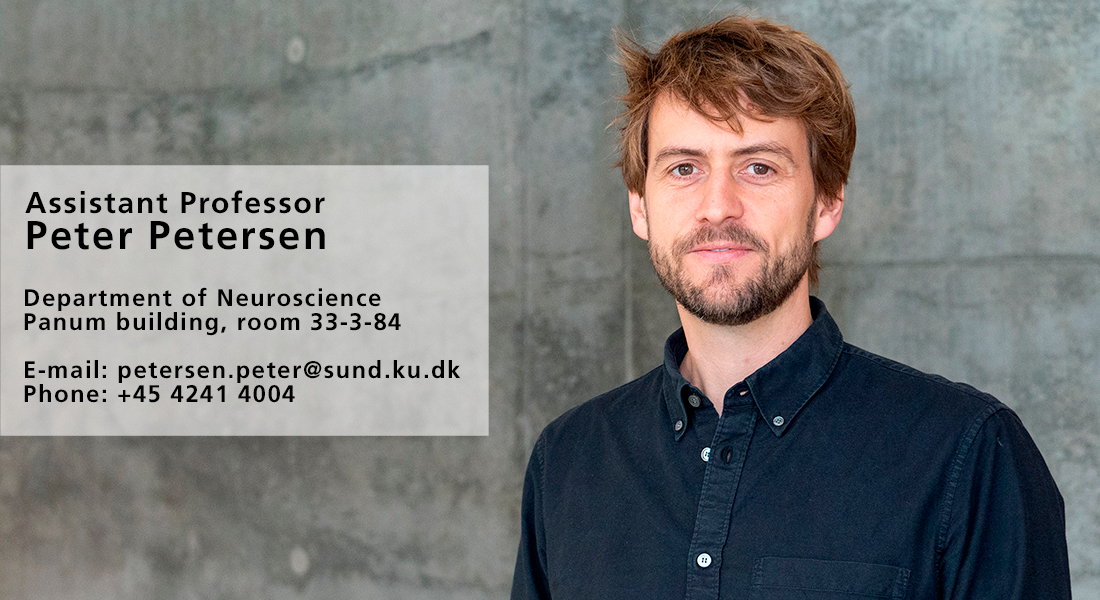Petersen Lab
Our goal is to understand the neuronal mechanisms involved in memory and cognition and how imbalances in the circuits can lead to pathological conditions. In particular, we study spatial memory, and theta oscillations in behaving rats, and how the distributed populations of neurons across the distributed brain circuits central to memory, are coordinating their dynamics to generate complex cognitive functions.

Our goal is to understand the neuronal mechanisms involved in memory and cognition and how imbalances in the circuits can lead to pathological conditions. In particular, we study spatial memory, and theta oscillations in behaving rats, and how the distributed populations of neurons across the distributed brain circuits central to memory, are coordinating their dynamics to generate complex cognitive functions.
We are using state-of-the-art methods for measuring and manipulating the neuronal activity at large-scale and high specificity, together with advanced data analysis. This includes using Neuropixels and other high-density silicon probes, applying optogenetics, thermal and other perturbation techniques, dimensionality reduction, and other advanced population-analysis methods.
We are also strong supporters of open science and have developed multiple tools and solutions for the neuroscience community (both software and hardware solutions) and we are sharing our data and code for published studies. Check out our website for further information: https://petersenlab.org/
-
Viktor Varga, Peter C. Petersen, Ipshita Zutshi, Roman Huszar, Yiyao Zhang, György Buzsáki, Working memory features are embedded in hippocampal place fields. Cell Reports, March 26, 2024
-
Henrik Linden, Peter C. Petersen, Mikkel Vestergaard, Rune W. Berg. Movement is governed by rotational population dynamics in spinal motor networks. Nature, October 12, 2022.
-
Peter C. Petersen*, Mihály Vöröslakos*, György Buzsáki. Brain temperature affects quantitative features of hippocampal sharp wave ripples. *cofirst author. Journal of Neurophysiology, June 2022.
-
Peter C. Petersen*, Joshua H. Siegle, Nicholas A. Steinmetz, Sara Mahallati, György Buzsáki*. CellExplorer: A framework for visualizing and characterizing single neurons. *corresponding author. Neuron, September 29, 2021.
-
Mihály Vöröslakos*, Peter C. Petersen*, Balázs Vöröslakos*, György Buzsáki. Metal microdrive and head cap system for silicon probe recovery in freely moving rodent. *cofirst author,eLife, May 19, 2021.
-
Peter C. Petersen, György Buzsáki. Cooling of Medial Septum Reveals Theta Phase Lag Coordination of Hippocampal Cell Assemblies. Neuron, June 2020.
-
Peter C. Petersen, Rune W. Berg. Lognormal firing rate distribution reveals prominent fluctuation-driven regime in spinal motor networks. eLife, October 26, 2016.
-
Adrien Peyrache, Marie M. Lacroix, Peter C. Petersen, György Buzsáki. Self-organized mechanisms of the head direction sense. Nature Neuroscience, March 26, 2015, 18:569–575.
- Peter C. Petersen, Mikkel Vestergaard, Kristian H. R. Jensen, Rune W. Berg. Premotor Spinal Network with Balanced Excitation and Inhibition during Motor Patterns Has High Resilience to Structural Division. Journal of Neuroscience, February 19, 2014, 34(8):2774 –2784.
Research Experience
2022-present: Assistant Professor and Group Leader at the Department of Neuroscience at University of Copenhagen.
2016-2022: Postdoc fellow with Gyorgy Buzsaki, NYU Langone Medical Center, USA.
2015: Postdoc fellow with Rune W. Berg, Department of Neuroscience and Pharmacology, University of Copenhagen, Denmark.
Education
2015: Ph.D. from University of Copenhagen
- Rune Berg’s laboratory at the Department of Neuroscience and Pharmacology
“Neuronal Population dynamics and Multifunctionalism in the Central Nervous System”. Techniques: electrophysiology, intracellular and multiunit recordings.
www.berg-lab.net - György Buzsáki’s laboratory at New York University (6 months, 2012-2013)
Study: The Head-direction system in thalamus during different brain states. In collaboration with Dr. Adrien Peyrache. Techniques: in vivo electrophysiology, optogenetics, high-density single-unit recordings, spike sorting.
www.buzsakilab.com
2010: Master of Science in Engineering Physics: Technical University of Denmark
- Focus on Biophysics and Neuroscience
Selected Courses: Computational Neuroscience, Neurophysics, Cellular Biophysics, Introduction to Cognitive Psychology, Introduction to Systems Biology. - Thesis in Neuroscience
“Neuronal Population Coding during Functional Motor Activity – A Multiunit Study in the Spinal Cord”. Supervisors: Jakob Kisbye Dreyer & Kirstine Berg Sørensen. - Study abroad at University of Maryland in Washington D.C. (6 months, 2007)
Courses: Neurobiology Laboratory, Introduction to Neuroscience, Introduction to Cognitive Science.
Special Training
Berkeley course in mining and modeling of neuroscience data 2015. Redwood Center for Theoretical Neuroscience, UC Berkeley, California USA. July 6-17 2015. crcns.org/course
Advanced Course in Computational Neuroscience: ACCN 2014. Frankfurt, Germany August 3-30 2014. 4 weeks course in computational methods and theoretical neuroscience.
Scientific awards and honors
2022: Lundbeck Fellow starting grant
2020: Kavli Foundation NWB Seed Grant
2018-2019: Lundbeckfonden Post-doctoral fellowship
2016-2017: Danish Council for Independent Research Postdoctoral fellowship
2015: Alfred Benzon Post-doctoral Fellowship
2013: The Brain Prize Young investigator travel grant
Description of techniques
We are using state-of-the-art methods for measuring and manipulating the neuronal activity at large-scale and high specificity, together with advanced data analysis.
Large-scale electrophysiology: We implant Neuropixels probes and other high-density silicon probes to record hundreds of single neurons and population dynamics across multiple brain regions in behaving rodents.
Circuit and behavioral perturbation: We use optogenetics and thermal perturbation to manipulate the activity of genetically defined cell types and brain regions in order to dissect their contribution to specific behaviors and cognitive functions.
Behavioral paradigms: We develop novel behavioral tasks for complex spatial learning to understand the cognitive processes involved.
Data analysis and theory: We apply novel analysis methods for large-scale neural datasets (both single cells, population level and LFP analysis methods), including dimensionality reduction, and other advanced population-analysis methods. And our experiments are guided by theory and computational models.
Imaging techniques: We use histological methods together with advanced microscopy and other imaging techniques.
Lab members
| First name | Surname | Title | Job responsibilities | |
|---|---|---|---|---|
| Search in First name | Search in Surname | Search in Title | Search in Job responsibilities | |
| Anne Marie Nordvig | Petersen | Laboratory Technician | Perrier Lab |
|
| Julia | Czurylo | Research Assistant | NAD |
|
| Peter C. | Petersen | Assistant Professor | Petersen lab |
|
| Shuhan | Yang | Research Assistant | Petersen Lab |
|
| Viktor Wisniewski | Bendtsen | Research Assistant | NAD |
|
